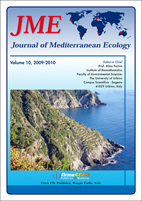JME 2009-2010
Giulia Benassi, Corrado Battisti, Luca Luiselli
In this study we used a set of data related to a network of 16 wetland fragments in Central Italy (Litorale romano, Rome) with the aim to study the level of stress experimented by a breeding bird assemblage following the Abundance/Biomasse Comparisons (ABC) approach. A comparison of the ABC curves among fragments showed that the abundance curves never exceeded biomass curves. A partial overlap between the curves was found in the smaller fragments. Fragments with higher surface (> 4 ha) revealed a similar trend of both curves, showing a greater number of species with low abundance values. Larger fragments show strong differences in the abundance/biomass values of individual species, thus indicating that dominant species are characterized by high body weight impacting heavily on the energy balance of the area. Therefore, larger fragments are capable of supporting more species either in the space-level (more niche available for a greater number of species), or trophic-energetic level(more resources and more potential species with high body size and total biomass).
Keywords: Abundance, biomass, ABC curves, birds assemblages, wetland fragments
Methods for the sustainability evaluation of coastal zone
Fabiano M., Marin V. , Paoli C. , Vassallo P.
Coastal zone sustainability is a key issue frequently expressed in vague terms. In this paper, we describe the state of the art of methods commonly applied for the evaluation of coastal zone sustainability at European level and we suggest innovative techniques adopting a whole system approach. Sustainability is in fact here defined as an emergent property, thus requiring a whole system view to be addressed and interpreted.
Keywords: Mediterranean coast, Emergy, Ecological footprint, WG-ID indicators, ICZM, DEDUCE
Quantifying Biological Integrity of California Sage Scrub Communities Using Plant Life-form Cover
Y. Hamada, D.A. Stow, J. Franklin
The California sage scrub (CSS) community type in California’s Mediterranean-type ecosystems supports a large number of rare, threatened, and endangered species, and is critically degraded and endangered. Monitoring ecological variables that provide information about community integrity is vital to conserving these biologically diverse communities. Fractional cover of true shrub, subshrub, herbaceous vegetation, and bare ground should fill information gaps between generalized vegetation type maps and detailed field-based plot measurements of species composition and provide an effective means for quantifying CSS community integrity. Remote sensing is the only tool available for estimating spatially comprehensive fractional cover over large extent, and fractional cover of plant life-form types is one of the measures of vegetation state that is most amenable to remote sensing. The use of remote sensing does not eliminate the need for either field surveying or vegetation type mapping; rather it will likely require a combination of approaches to reliably estimate life-form cover and to provide comprehensive information for communities. According to our review and synthesis, life-form fractional cover has strong potential for providing ecologically meaningful intermediate-scale information, which is unattainable from vegetation type maps and species-level field measurements. Thus, we strongly recommend incorporating fractional cover of true shrub, subshrub, herb, and bare ground in CSS community monitoring methods. Estimating life-form cover at a 25 m x 25 m spatial scale using remote sensing would be an appropriate approach for initial implementation. Investigation of remote sensing techniques and an appropriate spatial scale; collaboration of resource managers, biologists, and remote sensing specialists, and refinement of protocols are essential for integrating life-form fractional cover mapping into strategies for sustainable long-term CSS community management.
Keywords:
